高中英语强调句和倒装句--精华集锦
- 格式:doc
- 大小:105.50 KB
- 文档页数:11

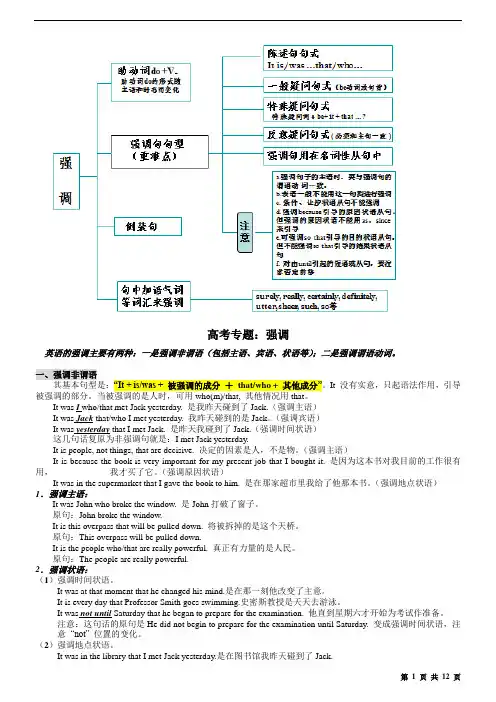
高考专题:强调英语的强调主要有两种:一是强调非谓语(包括主语、宾语、状语等);二是强调谓语动词。
一、强调非谓语其基本句型是:“It + is/was + 被强调的成分+that/who + 其他成分”。
It 没有实意,只起语法作用,引导被强调的部分。
当被强调的是人时,可用who(m)/that, 其他情况用that。
It was I who/that met Jack yesterday. 是我昨天碰到了Jack.(强调主语)It was Jack that/who I met yesterday. 我昨天碰到的是Jack。
(强调宾语)It was yesterday that I met Jack. 是昨天我碰到了Jack.(强调时间状语)这几句话复原为非强调句就是:I met Jack yesterday.It is people, not things, that are decisive. 决定的因素是人,不是物。
(强调主语)It is because the book is very important for my present job that I bought it. 是因为这本书对我目前的工作很有用,我才买了它。
(强调原因状语)It was in the supermarket that I gave the book to him. 是在那家超市里我给了他那本书。
(强调地点状语)1.强调主语:It was John who broke the window. 是John打破了窗子。
原句:John broke the window.It is this overpass that will be pulled down. 将被拆掉的是这个天桥。
原句:This overpass will be pulled down.It is the people who/that are really powerful. 真正有力量的是人民。
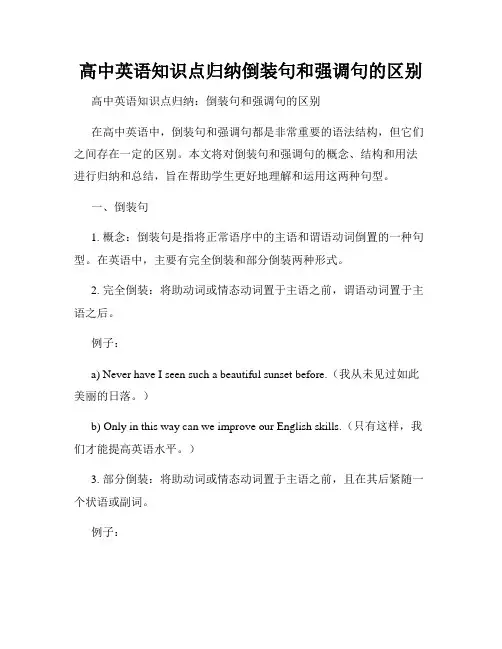
高中英语知识点归纳倒装句和强调句的区别高中英语知识点归纳:倒装句和强调句的区别在高中英语中,倒装句和强调句都是非常重要的语法结构,但它们之间存在一定的区别。
本文将对倒装句和强调句的概念、结构和用法进行归纳和总结,旨在帮助学生更好地理解和运用这两种句型。
一、倒装句1. 概念:倒装句是指将正常语序中的主语和谓语动词倒置的一种句型。
在英语中,主要有完全倒装和部分倒装两种形式。
2. 完全倒装:将助动词或情态动词置于主语之前,谓语动词置于主语之后。
例子:a) Never have I seen such a beautiful sunset before.(我从未见过如此美丽的日落。
)b) Only in this way can we improve our English skills.(只有这样,我们才能提高英语水平。
)3. 部分倒装:将助动词或情态动词置于主语之前,且在其后紧随一个状语或副词。
例子:a) Hardly had she started her speech when the power went out.(她刚开始演讲,电源就断了。
)b) Not only did he pass the test, but he also got the highest score.(他不仅通过了考试,而且还得到了最高分。
)二、强调句1. 概念:强调句是为了强调句子中的某个成分,在句子中将被强调的成分提前,并使用强调句型进行表达。
2. 结构:在强调句中,一般使用"It is/was + 被强调的部分 +that/who"的结构。
例子:a) It is John who broke the window.(打破窗户的是约翰。
)b) It was yesterday that we had the meeting.(开会是在昨天。
)3. 注意事项:在强调句中,如果被强调的是疑问词,如who, what, when等,则使用"It is/was + 被强调的疑问词 + that/who"的结构。
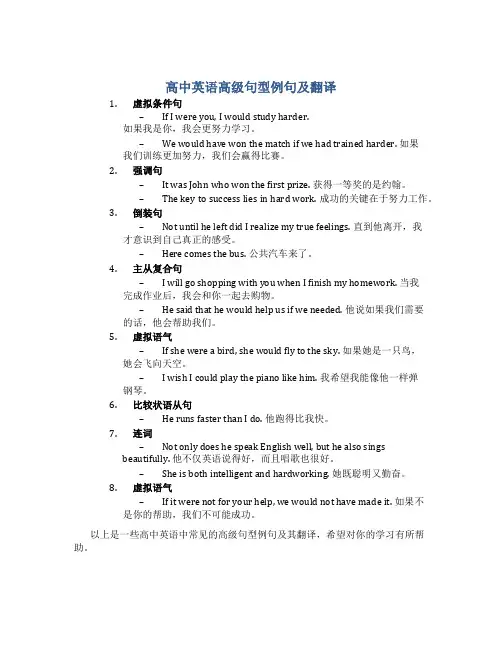
高中英语高级句型例句及翻译1.虚拟条件句–If I were you, I would study harder.如果我是你,我会更努力学习。
–We would have won the match if we had trained harder. 如果我们训练更加努力,我们会赢得比赛。
2.强调句–It was John who won the first prize. 获得一等奖的是约翰。
–The key to success lies in hard work. 成功的关键在于努力工作。
3.倒装句–Not until he left did I realize my true feelings. 直到他离开,我才意识到自己真正的感受。
–Here comes the bus. 公共汽车来了。
4.主从复合句–I will go shopping with you when I finish my homework. 当我完成作业后,我会和你一起去购物。
–He said that he would help us if we needed. 他说如果我们需要的话,他会帮助我们。
5.虚拟语气–If she were a bird, she would fly to the sky. 如果她是一只鸟,她会飞向天空。
–I wish I could play the piano like him. 我希望我能像他一样弹钢琴。
6.比较状语从句–He runs faster than I do. 他跑得比我快。
7.连词–Not only does he speak English well, but he also singsbeautifully. 他不仅英语说得好,而且唱歌也很好。
–She is both intelligent and hardworking. 她既聪明又勤奋。
8.虚拟语气–If it were not for your help, we would not have made it. 如果不是你的帮助,我们不可能成功。
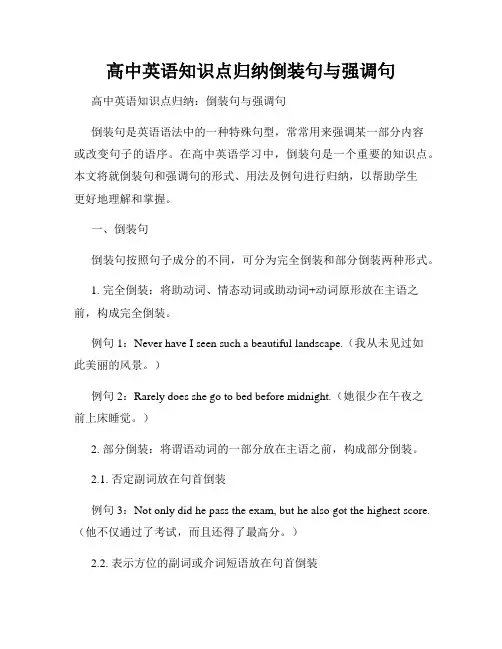
高中英语知识点归纳倒装句与强调句高中英语知识点归纳:倒装句与强调句倒装句是英语语法中的一种特殊句型,常常用来强调某一部分内容或改变句子的语序。
在高中英语学习中,倒装句是一个重要的知识点。
本文将就倒装句和强调句的形式、用法及例句进行归纳,以帮助学生更好地理解和掌握。
一、倒装句倒装句按照句子成分的不同,可分为完全倒装和部分倒装两种形式。
1. 完全倒装:将助动词、情态动词或助动词+动词原形放在主语之前,构成完全倒装。
例句1:Never have I seen such a beautiful landscape.(我从未见过如此美丽的风景。
)例句2:Rarely does she go to bed before midnight.(她很少在午夜之前上床睡觉。
)2. 部分倒装:将谓语动词的一部分放在主语之前,构成部分倒装。
2.1. 否定副词放在句首倒装例句3:Not only did he pass the exam, but he also got the highest score.(他不仅通过了考试,而且还得了最高分。
)2.2. 表示方位的副词或介词短语放在句首倒装例句4:Out rushed the students when the bell rang.(铃声一响,学生们就冲了出去。
)2.3. 在以“so/such+形容词/副词”作状语的句子中,将“so/such”放在句首倒装,强调后面的形容词/副词。
例句5:So beautiful is the sunset that everyone stops to admire it.(夕阳是如此美丽,以至于每个人都驻足欣赏。
)二、强调句强调句主要通过倒装句的形式,将要强调的成分放在句首,从而突出强调的重点。
1. 强调句的基本结构为“It is/was + 被强调成分 + that/who + 句子其他部分”。
例句6:It was John who broke the window.(是约翰打破了窗户。
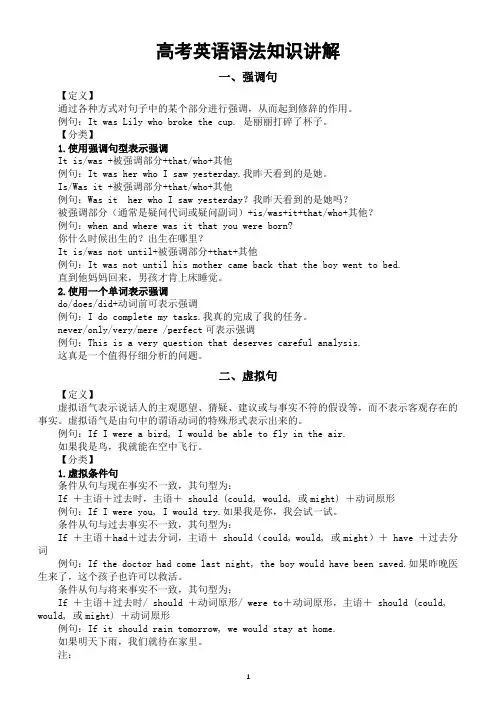
高考英语语法知识讲解一、强调句【定义】通过各种方式对句子中的某个部分进行强调,从而起到修辞的作用。
例句:It was Lily who broke the cup. 是丽丽打碎了杯子。
【分类】1.使用强调句型表示强调It is/was +被强调部分+that/who+其他例句:It was her who I saw yesterday.我昨天看到的是她。
Is/Was it +被强调部分+that/who+其他例句:Was it her who I saw yesterday?我昨天看到的是她吗?被强调部分(通常是疑问代词或疑问副词)+is/was+it+that/who+其他?例句:when and where was it that you were born?你什么时候出生的?出生在哪里?It is/was not until+被强调部分+that+其他例句:It was not until his mother came back that the boy went to bed.直到他妈妈回来,男孩才肯上床睡觉。
2.使用一个单词表示强调do/does/did+动词前可表示强调例句:I do complete my tasks.我真的完成了我的任务。
never/only/very/mere /perfect可表示强调例句:This is a very question that deserves careful analysis.这真是一个值得仔细分析的问题。
二、虚拟句【定义】虚拟语气表示说话人的主观愿望、猜疑、建议或与事实不符的假设等,而不表示客观存在的事实。
虚拟语气是由句中的谓语动词的特殊形式表示出来的。
例句:If I were a bird, I would be able to fly in the air.如果我是鸟,我就能在空中飞行。
【分类】1.虚拟条件句条件从句与现在事实不一致,其句型为:If +主语+过去时,主语+ should (could, would, 或might) +动词原形例句:If I were you, I would try.如果我是你,我会试一试。
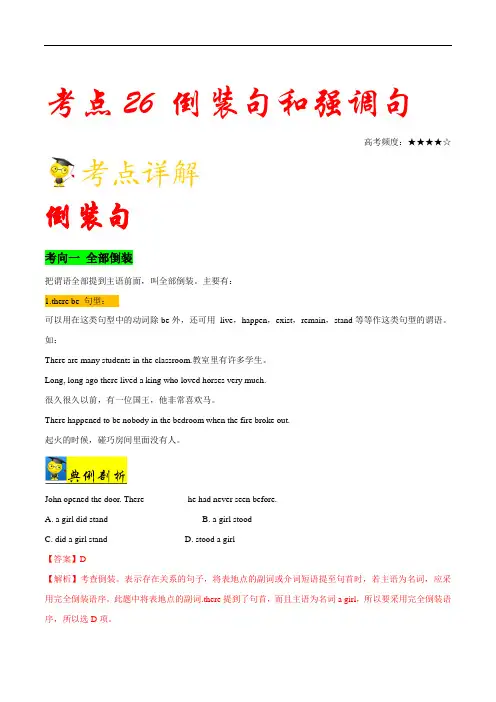
考点26 倒装句和强调句高考频度:★★★★☆倒装句考向一全部倒装把谓语全部提到主语前面,叫全部倒装。
主要有:1.there be 句型:可以用在这类句型中的动词除be外,还可用live,happen,exist,remain,stand等等作这类句型的谓语。
如:There are many students in the classroom.教室里有许多学生。
Long, long ago there lived a king who loved horses very much.很久很久以前,有一位国王,他非常喜欢马。
There happened to be nobody in the bedroom when the fire broke out.起火的时候,碰巧房间里面没有人。
John opened the door. There _________ he had never seen before.A. a girl did standB. a girl stoodC. did a girl standD. stood a girl【答案】D【解析】考查倒装。
表示存在关系的句子,将表地点的副词或介词短语提至句首时,若主语为名词,应采用完全倒装语序。
此题中将表地点的副词.there提到了句首,而且主语为名词a girl,所以要采用完全倒装语序,所以选D项。
2.Here/There/Now+vi.(常为come, go)+主语(必须是名词)此句型中here/there用来唤起注意意思是"喂,注意了"。
如:Here comes Mary. → I can see Mary coming.玛丽来了。
There goes the bell. 铃响了。
→I can hear the bell ringing.Here comes the bus.汽车来了。
There he comes.他来了。
这种句型不能用现在进行时。
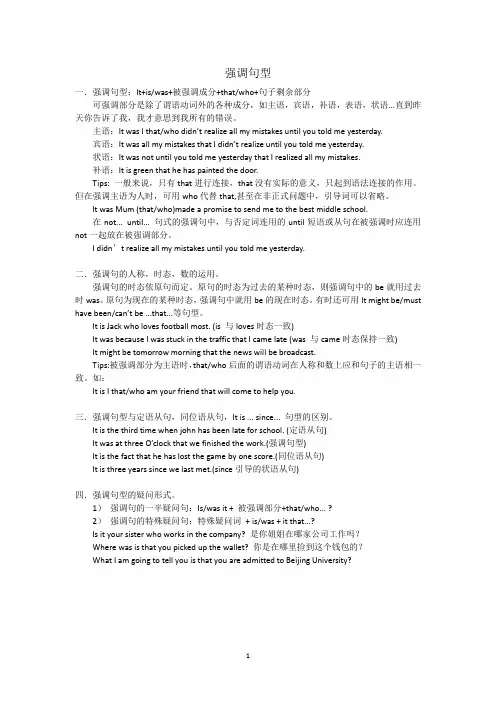
一.强调句型:It+is/was+被强调成分+that/who+句子剩余部分可强调部分是除了谓语动词外的各种成分,如主语,宾语,补语,表语,状语...直到昨天你告诉了我,我才意思到我所有的错误。
主语:It was I that/who didn’t realize all my mistakes until you told me yesterday.宾语:It was all my mistakes that I didn’t realize until you told me yesterday.状语:It was not until you told me yesterday that I realized all my mistakes.补语:It is green that he has painted the door.Tips: 一般来说,只有that进行连接,that没有实际的意义,只起到语法连接的作用。
但在强调主语为人时,可用who代替that,甚至在非正式问题中,引导词可以省略。
It was Mum (that/who)made a promise to send me to the best middle school.在not... until... 句式的强调句中,与否定词连用的until短语或从句在被强调时应连用not一起放在被强调部分。
I didn’t realize all my mistakes until you told me yesterday.二.强调句的人称,时态,数的运用。
强调句的时态依原句而定。
原句的时态为过去的某种时态,则强调句中的be就用过去时was。
原句为现在的某种时态,强调句中就用be的现在时态。
有时还可用It might be/must have been/can’t be ...that...等句型。
It is Jack who loves football most. (is 与loves时态一致)It was because I was stuck in the traffic that I came late (was 与came时态保持一致)It might be tomorrow morning that the news will be broadcast.Tips:被强调部分为主语时,that/who后面的谓语动词在人称和数上应和句子的主语相一致。
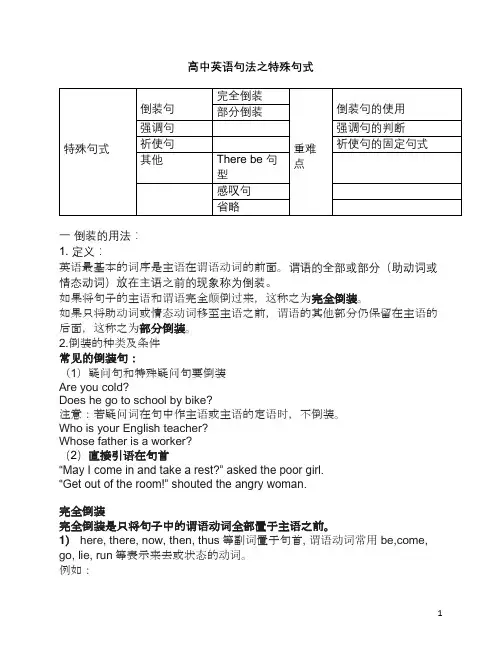
高中英语句法之特殊句式一倒装的用法:1. 定义:英语最基本的词序是主语在谓语动词的前面。
谓语的全部或部分(助动词或情态动词)放在主语之前的现象称为倒装。
如果将句子的主语和谓语完全颠倒过来,这称之为完全倒装。
如果只将助动词或情态动词移至主语之前,谓语的其他部分仍保留在主语的后面,这称之为部分倒装。
2.倒装的种类及条件常见的倒装句:(1)疑问句和特殊疑问句要倒装Are you cold?Does he go to school by bike?注意:若疑问词在句中作主语或主语的定语时,不倒装。
Who is your English teacher?Whose father is a worker?(2)直接引语在句首“May I come in and take a rest?” asked the poor girl.“Get out of the room!” shouted the angry woman.完全倒装完全倒装是只将句子中的谓语动词全部置于主语之前。
1) here, there, now, then, thus等副词置于句首, 谓语动词常用be,come, go, lie, run等表示来去或状态的动词。
例如:Here comes the bus! (=The bus is coming here! 用一般现在时表示正在进行的动作。
)There goes the bell! = The bell is ringing. 铃响了!Then came the chairman. 那时总裁来了。
Then came the hour we had been looking forward to.我们期盼的时候到了。
Here is your letter. 你的信。
2)表示运动方向的副词或地点状语置于句首,以out, in, up, down, off, away等副词开头,谓语动词是表示“移动”的go, come, leave等句子里。
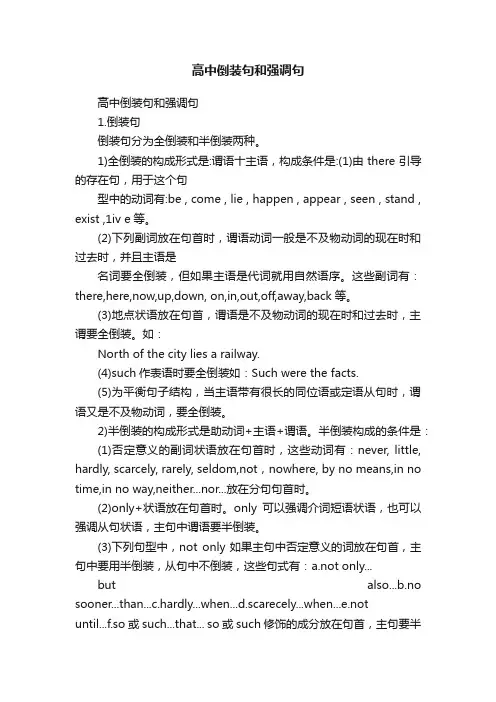
高中倒装句和强调句高中倒装句和强调句1.倒装句倒装句分为全倒装和半倒装两种。
1)全倒装的构成形式是:谓语十主语,构成条件是:(1)由there引导的存在句,用于这个句型中的动词有:be , come , lie , happen , appear , seen , stand , exist ,1iv e等。
(2)下列副词放在句首时,谓语动词一般是不及物动词的现在时和过去时,并且主语是名词要全倒装,但如果主语是代词就用自然语序。
这些副词有:there,here,now,up,down, on,in,out,off,away,back等。
(3)地点状语放在句首,谓语是不及物动词的现在时和过去时,主谓要全倒装。
如:North of the city lies a railway.(4)such作表语时要全倒装如:Such were the facts.(5)为平衡句子结构,当主语带有很长的同位语或定语从句时,谓语又是不及物动词,要全倒装。
2)半倒装的构成形式是助动词+主语+谓语。
半倒装构成的条件是:(1)否定意义的副词状语放在句首时,这些动词有:never, little, hardly, scarcely, rarely, seldom,not,nowhere, by no means,in no time,in no way,neither...nor...放在分句句首时。
(2)only+状语放在句首时。
only可以强调介词短语状语,也可以强调从句状语,主句中谓语要半倒装。
(3)下列句型中,not only如果主句中否定意义的词放在句首,主句中要用半倒装,从句中不倒装,这些句式有:a.not only...but also...b.no sooner...than...c.hardly...when...d.scarecely...when...e.not until...f.so或such...that... so或such修饰的成分放在句首,主句要半倒装that从句中不倒装。
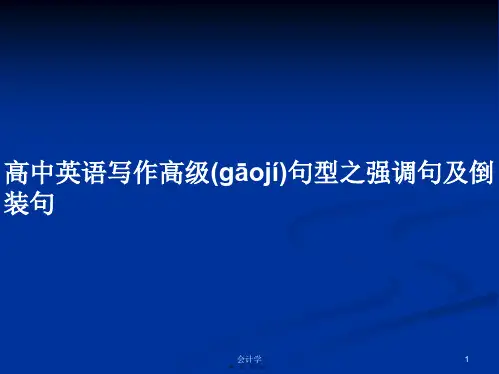
英语强调句学习要领1. 强调句的基本结构It+be+被强调成分+that (who)…He bought the book in this shop yesterday.→It was he that bought the book in this shop yesterday. (强调主语he)→It was the book that he bought in this shop yesterday. (强调宾语the book)→It was in this shop that he bought the book yesterday. (强调地点状语in this shop)【注】在该强调结构中,it is (was)…that (who)…为结构词,它通常可以省略,而不影响句子的意思。
2. 强调句用that还是who当被强调部分指人时,可以用who代that;当被强调部分指物时通常用that。
注意:强调事物时,通常不宜用which来代that,另外当强调时间或地点状语时,通常也不能用when / where代that(尤其是当这些状语为介词短语时)。
3. 关于被强调成分该强调句型中,被强调的成分除了是名词、代词、介词短语等之外, 也可以是从句:It is when he got back that he knew what had happened. 他回来后才知道所发生的情况。
It was because he loved my money that he married me. 他是因为爱我的钱才同我结了婚。
【注意】(1)该句型可强调because引导原因状语从句,但通常不能强调由 since, as引导的原因状语从句,另外也不强调由although引导的让步状语从句。
(2)该句型可以强调主语,但不强调表语。
4.强调句的疑问句形式(1).一般疑问句的强调结构一般疑问句的强调结构就是将be提到句首,即使用“Is / Was it+ 被强调部分 + that / who…”。
△特殊句式(强调,倒装)△强调句型一.基本句型It is+被强调部分+that/who/whom….[可强调主、宾、状(时状/地状/方状)、谓、不能定语]I met Tom on the street yesterday.主宾地状时状It was I who…It was Tom whom…It was yesterday that…It was on the street that…若强调谓语,用did/do/does强调;若祈使句强调,在开头加doI did meet Tom…注:错误!未找到引用源。
改写时保持主谓一致It is I who i s→am to blame for the accident.错误!未找到引用源。
It is/was not until…that… (不倒装)比:Not until +从句(不倒装)+助动词+主(半倒装)+….二.强调句型的一般疑问句/特殊疑问句Is/Was it+被强调部分+that….?Who/What/When/Where/How+ is/was it that…?What is it that you want me to say?三.强调状语从句的表达1. I was hit by a car when I was crossing the road?→It was when I was crossing the road that I was hit by a car.2. You can find the book where you left it.→It is where you left book that you can find it.3. I didn’t receive the manager’s reply until nearly a month later.介词+短语作时间短语,此时until为介词→It was not until nearly a month later that I received the manger’s reply.4. I didn’t go to bed until he came back.后为句子,until为连词引导时状→It was not until he came back that I went to bed.注:若为持续性动词,则一定用until;若为短暂性动词,则一定用not until 四.强调主从、宾从的表达1. What she did made me very angry.→It was what she did that made me very angry.2. I was very angry at what she said.→It was what she said that I was very angry at.五.强调句中含其它从句的表达1. We are living in an age when things are done computer.→It is an age when many things are done on computer that we are living in.2.There were dirty marks on her trousers where he had had wiped he hands.→It was on her trousers where she had wiped her hands that there were dirty. 六.其它比:It was 6:00 when I came back.It was at 6:00 that I came back.It is 6 years since I left here. 我离开这里已六年(since 后接可持续动词时,从动作的结束开始算;接短暂性动词时,即是原意)△倒装句一.全部倒装1. there,here,now,then,thus等副词置于句首,谓语动词常用be,come,go,lie,run,stand,fall 等的一般现在时或一般过去时Then came the age of knowledge economy.There goes the bell.Here comes the bus.注:主语是代词时不倒装Here we are.2. 表示方位的副祠或拟声词in,out,away,off,up,down,below,ahead等,表示位置转移的动词的一般过去时.Out rushed the tiger from among the bushes.Bang! Bang! Bang! Came the knocks at the door.注:如果主语是代词时,用正常语序Back he went again.3. 表方位的介词短语或副词(作表语,状语)位于句首时On the hill stands a great castle.In this chapter will be found a partial answer.Above is a young couple who moved in not long ago.4.Such 作表语时,位句首Such was Albert Einstein a simple man and the 20th century greatest scientist.Such are the facts.二.半倒装1.Only+ adv/ 介词短语/ 状语从句Only yesterday did he find out that his watch was missing.Only in this way can we solve the problems.Only after I failed in the exam did I realise the importance of studies.注:强调主语时,不能倒装。
⾼中英语强调句和倒装句--精华集锦强调句和倒装句倒装是⼀种语法⼿段。
在英语中,主语和谓语的语序通常是主语在前,谓语在后。
但有时谓语的全部或⼀部分却提到主语的前⾯,这种语序叫做倒装。
倒装的原因,⼀是语法结构的需要,⼀是为了强调。
强调句为了使句⼦的某⼀个成分受到强调,改变句⼦结构。
⾼考重点要求:1、掌握部分倒装,全部倒装的句型及倒装形式2、掌握倒装句的都中使⽤⽅式第⼀节知识点概述⼀、强调句为了突出某⼀部分重要信息,常常借⽤语法中的变换句⼦的正常语序,将某个成分置于句⾸或句末,或者通过词汇⼿段突出句⼦的某个成分。
1. it 为先⾏词的强调结构It was Li Ping who told me the news. (强调⼈时才能⽤who)It was in the park that I met him. (强调地点不能⽤where,只能⽤that)It was yesterday that I saw him off at the airport. (强调时间不能⽤when,只能⽤that)2. 助动词do 的强调作⽤在⾏为动词作谓语的句⼦中,常⽤“助动词do或did”+ 谓语“动词原形”表⽰强调语⽓。
例如:She did go to see him yesterday.We do have four lessons in the morning.⼆、倒装句句⼦的排列顺序,通常是主语在前,谓语在后。
倒装语序,谓语在前,主语在后。
陈述句⼀般都是⾃然语序,⼀般疑问句都是倒装语序。
例如:He speaks English.(陈述句,⾃然语序)Does he speak English?(疑问句倒装语序)倒装语序:全部倒装,整个谓语放在主语之前。
部分倒装,谓语中需要强调的是⼀部分放在主语之前,其他部分仍放在主语之后。
倒装语序的作⽤,着重强调部分放在句⾸,引⼈注⽬。
变化句⼦,使句⼦⽣动活泼。
例如:The bus comes home.(⾃然语序)Here comes the bus.(倒装语序)倒装句除疑问句及“there + be “句之外,陈述句为了强调谓语或谓语某个部分也常可⽤倒装句,另外so,neither,no等词经常⽤于对话简略答语的句⾸,⽤倒装语序避免重复。
高中英语知识点归纳倒装句和强调句的结构和用法高中英语知识点归纳:倒装句和强调句的结构和用法一、倒装句的结构和用法倒装句是指将动词或助动词提到主语之前的句子结构,主要分为完全倒装和部分倒装两种形式。
1. 完全倒装完全倒装句的结构为“倒装词+谓语+主语”。
主要使用以下几种情况:a. 当句首表地点的介词短语或副词表示地点时:例句:Under the tree stood a little girl.(树下站着一个小女孩。
)b. 当句首表方向的副词或介词短语表示方向时:例句:Out rushed the excited dog.(兴奋的狗冲了出去。
)c. 当表示部分意义的副词或介词短语放在句首时:例句:In front of the house lived an old couple.(房子前住着一对老夫妻。
)2. 部分倒装部分倒装句的结构为“谓语+倒装词+主语”。
主要使用以下几种情况:a. 当句首为否定词或含有否定意义的词语时:例句:Never have I seen such a beautiful sunset.(我从未见过如此美丽的日落。
)b. 当句首为表示条件的状语从句时:例句:Should you need any further assistance, please feel free to contact us.(如果您需要进一步的帮助,请随时与我们联系。
)c. 当句首为表示让步的状语从句时:例句:Hard as he worked, he didn't make much progress.(尽管他努力工作,但进展不大。
)二、强调句的结构和用法强调句是用来强调句子中的某一成分,使其在句子中显得突出和重要。
1. 结构强调句的结构为“It is/was + 被强调部分 + that/who + 句子其余部分”。
2. 用法a. 强调句型通常用在以下情况中:- 强调句子的主语:例句:It was John who won the first prize.(是约翰获得了第一名。
高中英语:强调句、语序、倒装语法知识点I强调句1 It is (was) that(who, whom)句型:It is (was) +被强调的成分+that(who, whom) +其它成分I am right. 我是对的。
It is I who(that) am right.(强调主语)They will have a meeting tomorrow. 他们明天开会。
It is they who (that) will have a meeting tomorrow.(强调主语)就是他们明天要开会。
It is a meeting that they will have tomorrow. (强调宾语)他们明天是要开个会(而不是干别的)。
It is tomorrow that they will have a meeting.(强调时间状语)就在明天他们要开会。
1. 强调句型应注意事项a. 强调句中通常强调主语、宾语(包括介词宾语)、状语、短语和从句。
it本身没有词义。
b. 强调句中的连接词一般只用who,whom(代人),that (可代物,也可代人),即使在强时间状语从句和地点状语从句时也如此。
who,whom,that不可以省略c. that或who,whom之后动词的人称和数要与它前面被强调的名词或代词一致。
(即人称和数要与原句中的一致)d. 强调句中的时态只有两种,一般现在时和一般过去时。
原句谓语动词是一般过去时,过去完成时和过去进行时时,用It was’其余的时态用It is。
It was the way he asked that really upset me.就是他问的方式真的使我生气了。
Was it during the Second World War that he died?(强调短语)他就是在第二次世界大战之中死的吗?When was it that the Long March started?是什么时候开始长征的?(强调句子)2. 强调 it 和先行词 it 的判别可用恢复原句来判别,即是把It is(was) that取消,如果剩下的仍能组成一个完整的句子,这就是强调句型,否则就不是。
强调句和倒装句倒装是一种语法手段。
在英语中,主语和谓语的语序通常是主语在前,谓语在后。
但有时谓语的全部或一部分却提到主语的前面,这种语序叫做倒装。
倒装的原因,一是语法结构的需要,一是为了强调。
强调句为了使句子的某一个成分受到强调,改变句子结构。
高考重点要求:1、掌握部分倒装,全部倒装的句型及倒装形式2、掌握倒装句的都中使用方式第一节知识点概述一、强调句为了突出某一部分重要信息,常常借用语法中的变换句子的正常语序,将某个成分置于句首或句末,或者通过词汇手段突出句子的某个成分。
1. it 为先行词的强调结构It was Li Ping who told me the news. (强调人时才能用who)It was in the park that I met him. (强调地点不能用where,只能用that)It was yesterday that I saw him off at the airport. (强调时间不能用when,只能用that)2. 助动词do 的强调作用在行为动词作谓语的句子中,常用“助动词do或did”+ 谓语“动词原形”表示强调语气。
例如:She did go to see him yesterday.We do have four lessons in the morning.二、倒装句句子的排列顺序,通常是主语在前,谓语在后。
倒装语序,谓语在前,主语在后。
陈述句一般都是自然语序,一般疑问句都是倒装语序。
例如:He speaks English.(陈述句,自然语序)Does he speak English?(疑问句倒装语序)倒装语序:全部倒装,整个谓语放在主语之前。
部分倒装,谓语中需要强调的是一部分放在主语之前,其他部分仍放在主语之后。
倒装语序的作用,着重强调部分放在句首,引人注目。
变化句子,使句子生动活泼。
例如:The bus comes home.(自然语序)Here comes the bus.(倒装语序)倒装句除疑问句及“there + be “句之外,陈述句为了强调谓语或谓语某个部分也常可用倒装句,另外so,neither,no等词经常用于对话简略答语的句首,用倒装语序避免重复。
第二节实战演练一、复习时需注意的要点1. 全部倒装的句型结构的主语必须是名词,如果主语是人称代词则不能完全倒装。
例如:Here he comes.Away they went.当so引出的句子用以对上文内容加以证实或肯定时,不可用倒装结构。
意为"的确如此"。
例如:Tom asked me to go to play football and so I did.—It's raining hard.—So it is.2、only在句首要倒装的情况例如:Only in this way, can you learn English well.Only after being asked three times did he come to the meeting.如果句子为主从复合句,则主句倒装,从句不倒装Only when he is seriously ill, does he ever stay in bed.3、在虚拟语气条件句中从句谓语动词有were, had, should等词,可将if 省略,把were, had, should 移到主语之前,采取部分倒装。
例如:Were I you, I would try it again.4、只有当Not only…but also连接两个分句时,才在第一个分句用倒装结构。
如果置于句首的Not only…but also仅连接两个并列词语,不可用倒装结构。
例如:Not only you but also I am fond of music.二、历届高考试题分析例1、The old couple have been married for 40 years and never once ________with each other.A. they had quarrelledB. they have quarrelledC. have they quarrelledD. had they quarreled答案选C。
【解析】考部分主谓倒装。
否定句(如该句中的never)在句首时,应用部分主谓倒装。
这类副词有:never ,hardly ,seldom ,scarcely,little等。
这句话的意思是:那对老夫妇结婚已经四十年了,连一次架也没吵过。
例2、Never before ____ in greater need of modern public transport than it is today.A. has this city beenB. this city has beenC. was this cityD. this city was答案:A【解析】表示否定含义的副词never 放句首用部分倒装。
例3、Only in this way_________ to make improvement in the operating system.A. you can hopeB. you did hopeC. can you hopeD. did you hope答案为C。
【解析】在含有only+状语的句子中,谓语动词要进行倒装。
这句话的意思是:只有用这种方法,才能改善操作系统。
例4、I feel it is your husband who _______ for the spoiled child.A. is to blameB. is going to blameC. is to be blamedD. shouldblame答案为A。
【解析】be to blame是固定短语,意思是“该受责备”。
这是一个强调句,强调主语your husband。
这句话的意思是:我感觉惯坏孩子该怨你的丈夫。
一些考生只注意到blame是及物动词,误选了is to be blamed,这表示将要发生的事,与语义不符。
例5、—You forgot your purse when you went out.—Good heavens, _______.A. so did IB. so I didC.I did soD.I so did答案为B。
【解析】“so+正装句”的意思是“是的”,表示同意别人所说的话。
所提供的情境Good heaven说明自己确实在出门时忘了带钱包,所以回答说:“so I did.”。
so I did的意思是“我确实忘了带钱包。
”注意区别so I did, so did I, I did so。
例:①“He sang this song just now.”—“So did I.”(我也是)②The doctor told me to breathe deeply.“I did so”.(我照着医生的吩咐做了深呼吸)③“You forget to post the letter for me.”—“So I did.”(我的确忘了邮信了)。
例6、Not only ________interested in football but ________ beginning to show an interest in it.A. the teacher himself is…all his students areB. the teacher himself is…are all his studentsC. is the teacher himself…are all his studentsD. is the teacher himself…all his students are答案为D。
【解析】Not only… but…引导的句子前一部分要用倒装。
这句话的意思是:不仅老师对足球感兴趣,学生们也开始对足球感兴趣了。
例7、So difficult ________it to live in an English-speaking country that I determined to learn English well.A. I have feltB. have I feltC. I did feelD. did I feel答案为D。
【解析】以“so+形容词”开头的句子要倒装。
此句变为不倒装句为:I felt it so difficult to live in an English country that I determined to learn English well.这句话的意思是:在一个说英语的国家里生活那么困难,我决定学习英语。
例8、_______can you expect to get a pay rise.A. With hard workB. Although work hardC. Only with hard workD. Now that he works hard答案为C。
【解析】Only+介词短语(副词、状语从句)+部分倒装。
例9、Only when the war was over ________to his hometown.A. did the young soldier returnB. the young soldier returnedC. returned the young soldierD. the young soldier did return答案为A。
【解析】only+状语或状语从句作状语时主句要进行倒装。
本句是only+时间状语从句,所以后接的主句要倒装。
这句话的意思是:直到战争结束后,这个年轻的战士才得以返回故乡。
例10、An awful accident ________, however, occur the other day.A. doesB. didC. has toD. had to答案为B。
【解析】这是一个对谓语强调的句子。
时间状语the other day表示过去,所以要用一般过去时。
由于在主语和谓语中间插入了however,增加了试题的难度。
注意:对谓语强调句子必须用于肯定句的一般时中,在谓语动词前加did, does或do。
第三节巩固练习Direction: Beneath each of the following sentences there are four choices marked A, B, C and D. Choose the best answer that completes the sentence.1. Here you want to see.A. comes the comradeB. comes a comradeC. the comrade comesD. is coming a comrade2. Now your turn to keep guard.A. there isB. is goingC. comesD. has come3. Spring begins in March, then .A. April and May comeB. April is comingC. come April and MayD. is April coming4. He has finished his work, .A. I have finished soB. so finished IC. so can ID. so have I5. He can hardly drive a car, .A. so can’t IB. can’t I eitherC. I can’t tooD. neither can I6. than they started to work.A. No sooner they had got to the plantB. No sooner did they get to the plantC. No sooner had they got to the plantD. As soon as they got to the plant7. Not until Mr. Smith came to China what kind of a country she is.A. did he knowB. he knewC. he didn’t knowD. he could know8. Across the river .A. lies a new built bridgeB. lies a newly built bridgeC. a new built bridge liesD. a newly built bridge lies9. So fast that it’s difficult for us to imagine its speed.A. light travelsB. travels the lightC. do light travelsD. does light travel10. Not only the data fed into it, but it can also analyse them.A. can the computer memorizeB. the computer can memorizeC. do the computer memorizeD. can memorize the computer11. talk about the importance of English study.A. Little need IB. Little I needC. Little did I needD. Little I needed12. ill-mannered, the laziest and most irresponsible creature you could ever hope to meet.A. Not only is he … but he is alsoB. Not only is he … but also is heC. Not only he is … but also is heD. Not only be he … but also he be13. got outside than it began to rain.A. Not sooner I hadB. No sooner had IC. No sooner ID. I no sooner had got14. did Anne realize that there was danger.A. On entering the storeB. After he had entered the storeC. Only after entering the storeD. As soon as he entered the store15. Very seldom that two clocks or watches exactly agree.A. you findB. you will findC. you do findD. do you find16. You think everything will be all right in time. .A. So I doB. So I thinkC. Nor do ID. So do I17. Little that John would become a famous writer.A. we thoughtB. we thinkC. did we thinkD. we think of18. My brother had a bad cold last week, .A. so had IB. so I hadC. so did ID. so I did19. Not only to New York but also there for a time.A. has he been … he workedB. has he been … did he workC. he has been … did he workD. he has gone … did he work20. Not only a writer but also here.A. a doctor were wantedB. were a doctor wantedC. a doctor was wantedD. was a doctor wanted21. It was how the young man had learned five foreign languages attracted the audience’s interest.A. so thatB. whatC. in whichD. that22. Neither read, nor to write.A. can he … can heB. can he … he canC. he can…. Can heD. he can … he can23. Not Until the work to bed.A. did he finish … he wentB. he finished … he wentC. he finished … did he goD. he finished … had he gone24. It was a year ago I first met him here.A. whichB. thatC. in whichD. when25. Who is it is waiting outside the room?A. whoB. whomC. whichD. that26. It was not until 11 o’clock the experiment.A. did he finishB. that he finishedC. when they finishedD. that did he finish27. Barely had they seated themselves hurriedly in the theatre _____ the curtain went up.A. thanB. whenC. as soon asD. before28. I’d rather stay at home than go to see a film, .A. neither had heB. neither would heC. so had heD. so would he29. Often the girl sing in her room.A. hears heB. he hearsC. does he hearD. does hears he30. On the top of the hill where I once visited the monk.A. a temple standsB. does a temple standC. a temple stands thereD. stands a temple31. Was it because he was ill he asked for leave?A. andB. thatC. that’sD. so32. Is it in that factory this kind of cat is made?A. in whichB. whereC. thatD. which33. Not a single song at yesterday’s party.A. she sangB. sang sheC. did she singD. she did sing34. Not only _____ their money, but they were also in danger of losing their lives.A. lost theyB. they lostC. did they loseD. they did lose35. Barely time to catch the bus.A. did he hasB. he hasC. has heD. did he have36. On the stairs in red.A.a small dark-haired girl was sittingB.was sitting a small dark-haired girlC.sitting a small dark-haired girl wasD.was a small dark-haired girl sitting37. “May I use your calculator”“ .”A. Here is itB. Here are youC. Here the calculator isD. Here you are38.hot is the sun that we cannot go out at present.A. VeryB. TooC. SoD. Such39. do I get invited into his office.A. OnlyB. RarelyC. Not onlyD. Never before40. A few miles further on .A. the city lies of SpringfieldB. does the city of Springfield lieC. lies the city of SpringfieldD. where lies the city of Springfield41. Which sentence is right?A. Do the great Chinese people live long !B. Long live the great Chinese people !C. Long will the great Chinese people live !D. Long live for the great Chinese people !42. Which sentence is right.A.May you succeed !B. You may succeed!C. Succeed may you !D. Succeed you may!43. Very important in the farmers’ life .A. the radio weather report isB. the radio weather report has beenC. is the radio weather reportD. have been the radio weather report44. His parents are always strict with him . Only after hishomework to go out and play with his friends.A. he has finished , was he allowsB.he has finished , he is allowedC.he had finished , was he allowedD.he finished , is he allowed45. Only in this way expect to get over so many difficulties .A. we are sure toB. can weC. that we canD. that can we46. Was it during the Second World War _____ his family all died?A. thatB. thenC. whenD. in which47. I really don’t know _____ it was that answered the phone this morning.A. whyB. whoC. howD. whether48. It was ten years ____ he returned to his hometown and set out to revenge his dead father.A. sinceB. thatC. beforeD. when49.Beneath our feet _____ that our life depends on for food and clothing.A. the earth layB. the earth liesC. lies the earthD. does the earth lie50. He’ll never succeed , hard he tires.A. whateverB. despiteC. thoughD. however1. A2. C3. C4. D5. D6. C7. A8. B9. D 10. A 11. A 12. A 13. B 14. C 15. D 16. D 17. C 18. C 19. A 20. C 21. D 22. A 23. C 24. B 25. D 26. B 27. B 28. D 29. C 30. D 31. B 32. C 33. C 34. C 35. D 36. B 37. D 38. C 39. B 40. C 41. B 42. A 43. C 44. D 45. B 46. A 47. B 48. C 49. C 50. D11 / 11。